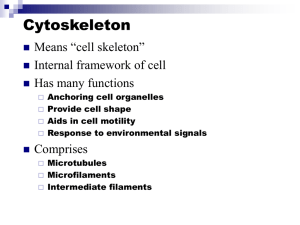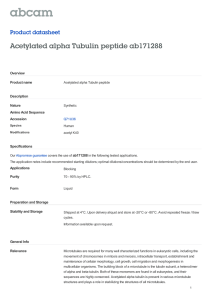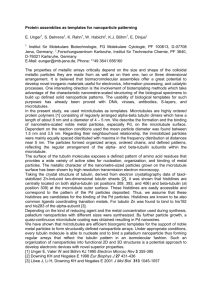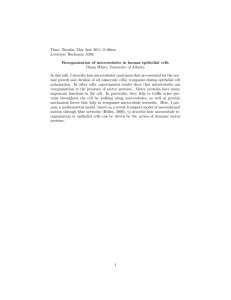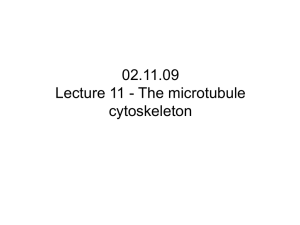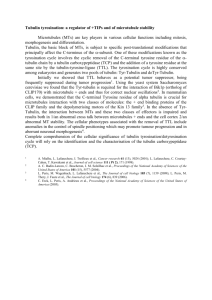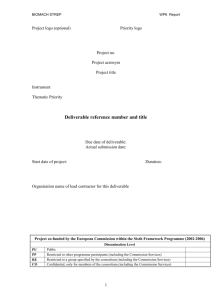Motor Proteins - Introduction Part 1 Biochemistry 4000 Dr. Ute Kothe
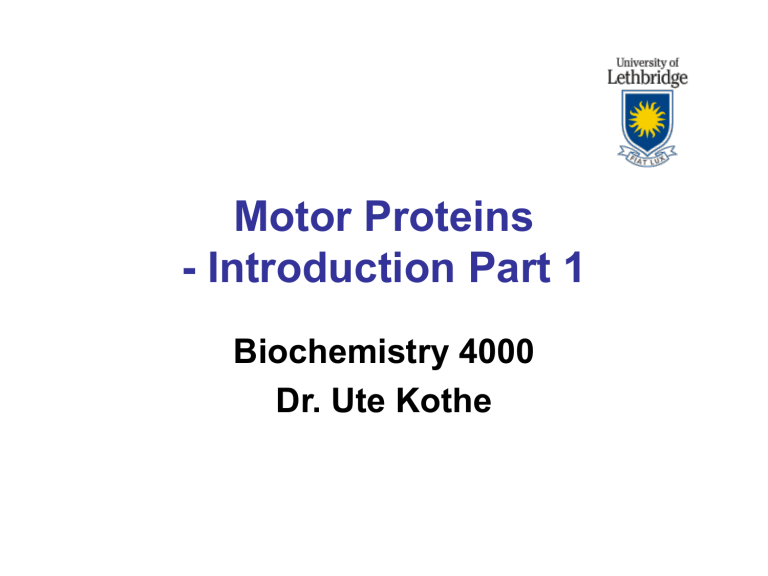
Motor Proteins
- Introduction Part 1
Biochemistry 4000
Dr. Ute Kothe
Motor Proteins
Motor Proteins convert chemical energy into motion.
• chemical energy is derived from ATP hydrolysis
• motion is generated by conformational changes depending on the bound nucleotide
Myosin Kinesin Dynein
Motor Protein Function
Myosin (18 known classes, 40 different myosins in humans)
Movement along actin fibres
• Muscle movement
• Cytokinesis (cytoplasmic division, tightening of contractile ring)
• Transport of cargo along microfilaments (vescicles etc.)
Kinesin (16 classes)
Movement along microtubule tracks , usually to (+) end
• Transport of cargos: vesicles, organelles, cytosolic components such as mRNAs & proteins, chromosomes
Dynein (12 mammalian dyneins)
Movement along microtubule tracks , to (-) end, i.e. cell center
• Cytoplasmic dyneins: transport of cargos such as vesicles
• Axonemal dyneins: Movement of cilia and flagella
Tubulin
• building block of microtubules
• heterodimer of closely related Tubulin a
& b
• G proteins : N-terminal residues fold into
G domain-like structure
• a
tubulin’s GTP buried at subunit interface, nonexchangable, not hydrolyzed
• b
tubulin’s GTP is solvent exposed until tubulin dimers polymerize
• upon polymerization, a
-tubulin from adjacent dimer provides catalytic residue to hydrolyze btubulin’s GTP; resulting
GDP is nonexchangeable unless tubulin dissociates from microtubule
Tubulin b
+ GDP
Tubulin a
+ GTP
Voet Fig. 35-89
Microtubules
1. Tubulins interact head to tail to form a long protofilament
2. Protofilaments align side by side in curved sheet
3. Sheet of 13 (9-16) protomers closes on itself to form microtubule
4. Microtubule lengthens by addition of tubulins to both ends
(preferentially to + end , i.e. the end terminating in b
-tubulins)
Voet Fig. 35-92
Structure of the Axoneme
• Bundle of microtubules called axoneme
• coated by plasma membrane
• Forms eukaroytic flagella & cilia
Voet Fig. 35-102
Dynein
• 1 or more heavy chains (motor domain)
• several intermediate and light chains
• motor domain is 7-membered ring, ATPhydrolyzing unit
• coiled-coil extension forms stalk that interacts via globular domain with microtubules
• long stem (with intermediate and light chains) binds cargo
Valle, Cell 2003; Voet Fig. 35-107
Conventional Kinesin
• two identical heavy chains forming two large globular heads attaching to microtubules and a coiled-coil
• two identical light chains interacting wit cargo
• transports vesicles and organelles in (-) to (+) direction (towards cell periphery)
Voet Fig. 35-94
Kinesin Structure
• Globular head : tubulin-binding site & nucleotide binding site
• flexible neck linker
• a
-helical stalk leading into coiled-coil
• ATP hydrolysis triggers conformational change in neck linker via 2 switch regions :
• When ATP is bound, neck linker docks with catalytic core
• Upon ATP hydrolysis, the neck linker
“unzips”
Voet Fig. 35-95 & 96 & 97
Kinesin Cycle
Voet Fig. 35-98
Hand-over-Hand Mechanism
ATP-bound state: strong microtuble binding
ADP-bound state: weak microtubule binding
1.
ATP binds to leading head - globular kinesin head which is already bound to the microtubule and oriented towards (+) end
2.
Neck linker of leading head “zips up” agains catalytic core
3.
trailing head is thrown forward (trailing head has bound ADP and reduced affinity to microtubule):
4.
Trailing head swings by ~ 160 Å, net movement of dimeric kinesin is ~ 80 Å = length of one microtubule dimer
5.
ATP in new trailing head is hydrolyzed & phosphate released: affinity for microtuble decreases
6.
ADP in new leading head dissociates
Two heads work in a coordinated fashion
ATP binding to leading head induces power stroke
Processivity
Kinesin is highly processive: it takes several 100 steps on a microtubule without detaching or sliding backwards!
How?
• coordinated, but out of phase ATP cycle in both heads
• one head is always firmly attached to microtubule
Movie demonstrating kinesins processivity: http://www.proweb.org/kinesin/axonemeMTs.html
Dynein
• 1 or more heavy chains (motor domain)
• several intermediate and light chains
• motor domain is 7-membered ring, ATPhydrolyzing unit
• coiled-coil extension forms stalk that interacts via globular domain with microtubules
• long stem (with intermediate and light chains) binds cargo
Valle, Cell 2003; Voet Fig. 35-107
